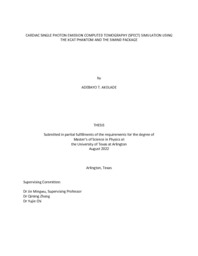
ATTENTION: The works hosted here are being migrated to a new repository that will consolidate resources, improve discoverability, and better show UTA's research impact on the global community. We will update authors as the migration progresses. Please see MavMatrix for more information.
Show simple item record
| dc.contributor.advisor | Mingwu, Jin | |
| dc.contributor.advisor | Zhang, Qiming | |
| dc.creator | Adebayo, Akolade | |
| dc.date.accessioned | 2022-09-15T11:47:15Z | |
| dc.date.available | 2022-09-15T11:47:15Z | |
| dc.date.created | 2022-08 | |
| dc.date.issued | 2022-08-17 | |
| dc.date.submitted | August 2022 | |
| dc.identifier.uri | http://hdl.handle.net/10106/30926 | |
| dc.description.abstract | Clinical data indicates a prevalence of transmural perfusion defects in the apical, mid, and basal segment of the left ventricle (LV) wall in patients with coronary artery diseases (CAD). To administer therapeutic regimes on myocardial function, detection of lesions in various region of the LV wall is essential. Cardiac single photon emission computed tomography (SPECT) is one of the most prevalent diagnostic tools to detect perfusion defects. Computer simulation using digital phantoms based on real patient data obtained from National Library of Medicine (NLM) offers a cost-effective approach to generate realistic imaging data to test novel imaging hardware and software ideas in the first place. This work aims to simulate cardiac SPECT using the Monte Carlo simulation (MCS) of 4D extended cardiac-torso (XCAT) Phantoms. In the first part of this work, we used the XCAT phantom program to generate different patients and perfusion defects at different location and with different sizes and severity. The XCAT phantoms are generated using nonuniform rational B-spline (NURBS) and subdivision surfaces to fit the real patient computed tomography (CT) data to provide detailed anatomical structures, as well as flexibility of definition of patient physiological motion and perfusion defects. The generation of a population of patients will provide a database that is important to investigate the impact of advanced SPECT reconstruction and compensation strategies for different patients and perfusion defects. In the second part of this work, we used the MCS package – SIMIND – to mimic 99mTc-sestamibi SPECT perfusion imaging of the XCAT phantom. The radiotracer decay, gamma photon transportation inside the human body, and photon detection by the gamma camera can be simulated in SIMIND accurately. The projection data from SIMIND highly resembles the real data acquired by a real SPECT system. These data will be used to develop and evaluate the compensation strategies for dual cardiac-respiratory gated SPECT for cardiac perfusion imaging to significantly improve the benefit-and-risk ratio of this prevalent diagnostic tool. | |
| dc.format.mimetype | application/pdf | |
| dc.language.iso | en_US | |
| dc.subject | Monte-Carlo, 4D XCAT, SIMIND, Technetium-99m. | |
| dc.title | CARDIAC SINGLE PHOTON EMISSION COMPUTED TOMOGRAPHY (SPECT) SIMULATION USING THE XCAT PHANTOM AND THE SIMIND PACKAGE | |
| dc.type | Thesis | |
| dc.degree.department | Physics | |
| dc.degree.name | Master of Science in Physics | |
| dc.date.updated | 2022-09-15T11:47:17Z | |
| thesis.degree.department | Physics | |
| thesis.degree.grantor | The University of Texas at Arlington | |
| thesis.degree.level | Masters | |
| thesis.degree.name | Master of Science in Physics | |
| dc.type.material | text | |
Files in this item
- Name:
- ADEBAYO-THESIS-2022.pdf
- Size:
- 2.219Mb
- Format:
- PDF
This item appears in the following Collection(s)
Show simple item record


